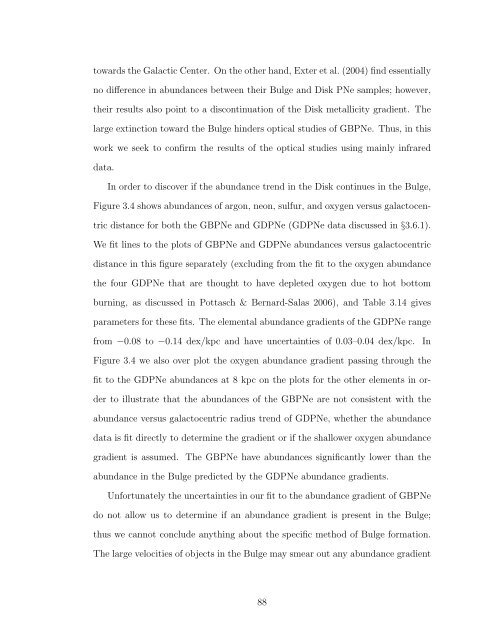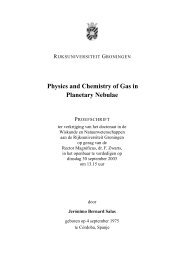TRACING ABUNDANCES IN GALAXIES WITH THE SPITZER ...
TRACING ABUNDANCES IN GALAXIES WITH THE SPITZER ...
TRACING ABUNDANCES IN GALAXIES WITH THE SPITZER ...
You also want an ePaper? Increase the reach of your titles
YUMPU automatically turns print PDFs into web optimized ePapers that Google loves.
towards the Galactic Center. On the other hand, Exter et al. (2004) find essentially<br />
no difference in abundances between their Bulge and Disk PNe samples; however,<br />
their results also point to a discontinuation of the Disk metallicity gradient. The<br />
large extinction toward the Bulge hinders optical studies of GBPNe. Thus, in this<br />
work we seek to confirm the results of the optical studies using mainly infrared<br />
data.<br />
In order to discover if the abundance trend in the Disk continues in the Bulge,<br />
Figure 3.4 shows abundances of argon, neon, sulfur, and oxygen versus galactocen-<br />
tric distance for both the GBPNe and GDPNe (GDPNe data discussed in §3.6.1).<br />
We fit lines to the plots of GBPNe and GDPNe abundances versus galactocentric<br />
distance in this figure separately (excluding from the fit to the oxygen abundance<br />
the four GDPNe that are thought to have depleted oxygen due to hot bottom<br />
burning, as discussed in Pottasch & Bernard-Salas 2006), and Table 3.14 gives<br />
parameters for these fits. The elemental abundance gradients of the GDPNe range<br />
from −0.08 to −0.14 dex/kpc and have uncertainties of 0.03–0.04 dex/kpc. In<br />
Figure 3.4 we also over plot the oxygen abundance gradient passing through the<br />
fit to the GDPNe abundances at 8 kpc on the plots for the other elements in or-<br />
der to illustrate that the abundances of the GBPNe are not consistent with the<br />
abundance versus galactocentric radius trend of GDPNe, whether the abundance<br />
data is fit directly to determine the gradient or if the shallower oxygen abundance<br />
gradient is assumed. The GBPNe have abundances significantly lower than the<br />
abundance in the Bulge predicted by the GDPNe abundance gradients.<br />
Unfortunately the uncertainties in our fit to the abundance gradient of GBPNe<br />
do not allow us to determine if an abundance gradient is present in the Bulge;<br />
thus we cannot conclude anything about the specific method of Bulge formation.<br />
The large velocities of objects in the Bulge may smear out any abundance gradient<br />
88













